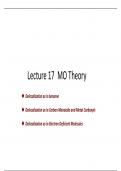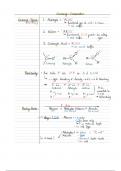Carbonyls - Study guides, Class notes & Summaries
Looking for the best study guides, study notes and summaries about Carbonyls? On this page you'll find 62 study documents about Carbonyls.
Page 2 out of 62 results
Sort by

-
CHEM 233 Final Exam Questions With Complete Solution
- Exam (elaborations) • 8 pages • 2023
- Available in package deal
-
- $10.49
- + learn more
Mass spectrometry correct answer: Technique that sorts ions based on their mass to charge ratio Electron ionization correct answer: -Also known as hard ionization -Very energetic, produces fragments ("daughter ions") Electrospray ionization correct answer: -Also known as soft ionization -Species remains intact, form ions by attaching H+ (+1 amu) or Na+ (+23 amu) 3:1 correct answer: Mass spectrometry ratio that appears for Cl 1:1 correct answer: Mass spectrometry ratio that a...
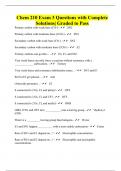
-
Chem 210 Exam 3 Questions with Complete Solutions| Graded to Pass
- Exam (elaborations) • 3 pages • 2023
- Available in package deal
-
- $9.99
- + learn more
Primary carbon with weak base (CN-) - SN2 Primary carbon with moderate base (CCH-) - SN2 Secondary carbon with weak base (CN-) - SN2 Secondary carbon with moderate base (CCH-) - E2 Tertiary carbons can go thru... - E2, E1, and SN1 Very weak bases can only force a reaction without resonance with a _____________ carbocation. - Tertiary Very weak bases and resonance stabilization cause... - SN1 and E1 B-H in E2 get placed... - Anti t-butoxide promotes...
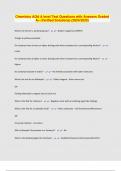
-
Chemistry AQA A level Test Questions with Answers Graded A+ (Verified Solutions) (2024/2025)
- Exam (elaborations) • 139 pages • 2024
-
- $15.48
- + learn more
Chemistry AQA A level Test Questions with Answers Graded A+ (Verified Solutions) (2024/2025) What's the Test for a Carbonyl group? - - Brady's reagent (2,4 DNPH) Orange to yellow precipitate Do Carbonyls have a lower or higher boiling point when compared to a corresponding Alcohol? - - Lower Do Carbonyls have a higher or lower boiling point when compared to a corresponding Alkane? - - Higher Do Carbonyls dissolve in water? - - Yes limited association with water molecules What's the t...
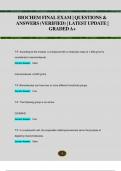
-
BIOCHEM FINAL EXAM | QUESTIONS & ANSWERS (VERIFIED) | LATEST UPDATE | GRADED A+
- Exam (elaborations) • 18 pages • 2024
-
- $12.49
- + learn more
1 BIOCHEM FINAL EXAM | QUESTIONS & ANSWERS (VERIFIED) | LATEST UPDATE | GRADED A+ T/F: According to the module, a compound with a molecular mass of 1,000 g/mol is considered a macromolecule. Correct Answer: false macromolecule >5,000 g/mol T/F: Biomolecules can have two or more different functional groups. Correct Answer: true T/F: The following group is an amine. C2H5NH2 Correct Answer: true T/F: In a eukaryotic cell, the organelles called peroxisomes serve the purpose of ...

-
NROS 307 quizzes with complete solutions
- Exam (elaborations) • 11 pages • 2024
- Available in package deal
-
- $11.49
- + learn more
what is the formula for resistors in series vs in parallel in series: add R= R1 +R2.. in parallel: 1/R= 1/R1+ 1/R2... What is Ohm's law equation? V=IR Previous Play Next Rewind 10 seconds Move forward 10 seconds Unmute 0:02 / 0:15 Full screen Brainpower Read More what is the formula for capacitors in series vs in parallel in series: 1/C = 1/C1 + 1/C2.. in parallel= C= C1 +C2.. what kind of molecules can pass the cell membrane lipid bilayer most easily? Wh...
Delocalization as in benzene Delocalization as in Carbon Monoxide and Metal Carbonyls Delocalization as in Electron Deficient Molecules
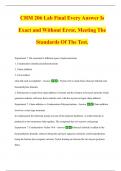
-
CHM 206 Lab Final Every Answer Is Exact and Without Error, Meeting The Standards Of The Test.
- Exam (elaborations) • 27 pages • 2024
-
- $12.49
- + learn more
Experiment 7: We examined 3 different types of polymerization 1. Condensation (interfacial polymerization) 2. Chain Addition 3. Cross-linked what did each accomplish? - Answer 1. Nylon-10,6 is made from sebacoyl chloride and hexamethylene diamine 2. Polystyrene is made from chain additon of styrene and the initiator as benzoyl peroxide which generates radicals with heat, these radicals react with the styrene to begin chain addition Experiment 7: Chain addition vs Condensation Polymerizat...
Detailed notes made using the OCR A level chemistry textbook, covering chapters 26 i.e. carbonyls and carboxylic acids

-
A2 Organic Chemistry Reactions, Reagents and Conditions questions well answered
- Exam (elaborations) • 4 pages • 2022
- Available in package deal
-
- $8.49
- + learn more
A2 Organic Chemistry Reactions, Reagents and Conditions questions well answeredChange of Functional Group in "Oxidation of Aldehydes". Aldehyde to Carboxylic Acid Reagent in "Oxidation of Aldehydes" Potassium dichromate (VI) solution and dilute sulphuric acid Conditions of "Oxidation of Aldehydes" Heat under Reflux Forming Tollen's Reagent Aqueous Ammonia and Silver Nitrate. Complex Ion in Tollen's Reagent [Ag(NH3)2]+ Conditions for Tollen's Reage...
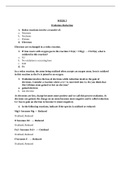
-
CHEM 120 Week 5 Oxidation Reduction Questions and Answers- Chamberlain College Atlanta
- Exam (elaborations) • 20 pages • 2023
- Available in package deal
-
- $15.98
- + learn more
CHEM 120 Week 5 Oxidation Reduction Questions and Answers- Chamberlain College Atlanta WEEK 5 Oxidation-Reduction 1. Redox reactions involve a transfer of: a. Neutrons b. Nucleons c. Protons d. Electrons Electrons are exchanged in a redox reaction. 2. If iron reacts with oxygen gas in the reaction 2 Fe(s) + O2(g) → 2 FeO(s), what is oxidized in this reaction? a. O2 b. No oxidation is occurring here c. FeO d. Fe In a redox reaction, the atom being oxidized often accepts an oxygen...

Study stress? For sellers on Stuvia, these are actually golden times. KA-CHING! Earn from your study resources too and start uploading now. Discover all about earning on Stuvia



